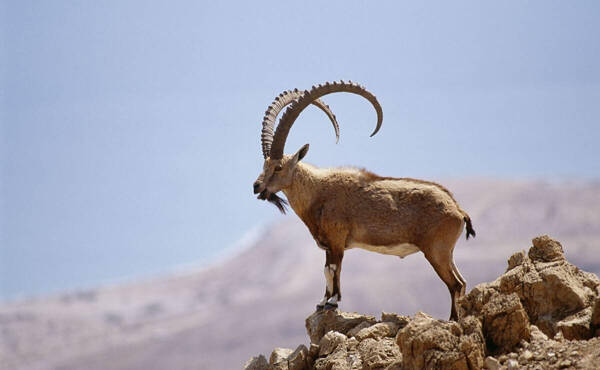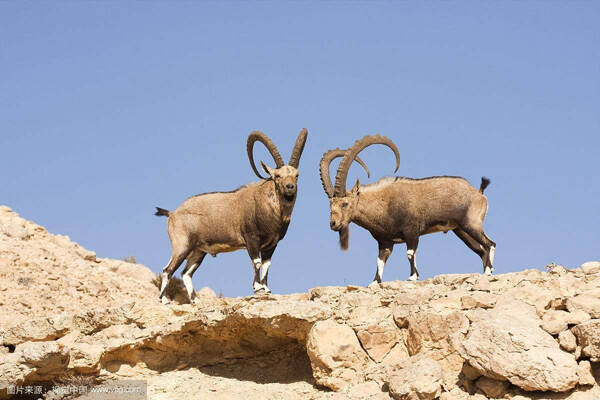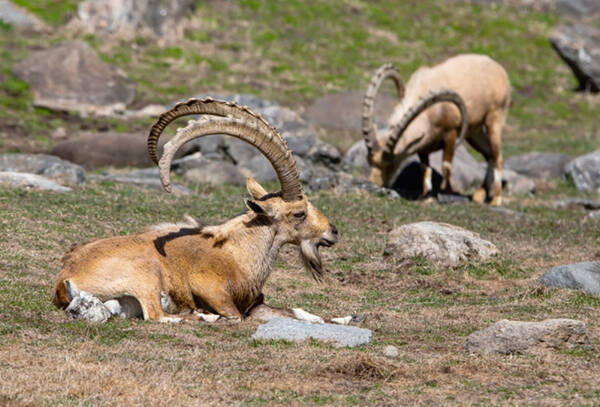Capra nubiana
IUCN
LCBasic Information
Scientific classification
- name:Capra nubiana
- Scientific Name:Capra nubiana
- Outline:Ungulata
- Family:Artiodactyla Bovidae Capra
Vital signs
- length:105-125cm
- Weight:25-120kg
- lifetime:10-16years
Feature
There are huge and majestic horns on the head, the longest record is 147.3 cm
Distribution and Habitat
Remained: Egypt, Israel, Jordan, Oman, Saudi Arabia, Sudan, and Yemen.
Extinct: Lebanon.
Uncertain: Eritrea and Ethiopia.
Reintroduced (remained): Syria.
The Nubian ibex is the only goat species adapted to life in the hot, arid regions of the world. They were once widespread in the mountains of northeastern Africa and the Middle East. Estimates of the full extent of this geographic range are based on ancient drawings and skeletal remains. But today the Nubian ibex is confined to coastal areas of northeastern Africa, the Sinai Peninsula, and the southeastern and western Arabian Peninsula, where a few isolated populations exist.
Habitat Temperate Terrestrial, Terrestrial Biome Desert or Dune. Inhabits rocky desert mountains, steep slopes and hills (which provide important escape routes), and plateaus, valleys, and depressions in arid areas with sparse vegetation. They live at different altitudes, from sea level to 3,000 meters above sea level. Most of the time, they live i
Appearance
The Nubian ibex is one of the smallest ibex species and is sexually dimorphic. The average size of a female ibex is about one-third that of a male. Body length is 105-125 cm, shoulder height is 65-75 cm; males weigh 40-120 kg, females 25-70 kg; tail length is 15-20 cm; both sexes have beards, about 7-15 cm long. The overall color is a uniform tan, matching the rocky, arid environment around it. The body hair is usually brownish-yellow in the summer and pale yellow in the winter. There are black and white patches on the legs, and the lower abdomen is white. Color change begins in August, with the male's neck, chest, shoulders, sides of the abdomen, front thighs, and upper forelegs turning dark brown to black. Males have long dark beards, which are used for scent marking and to excite females when in estrus. Older females also grow them.
The most striking physical feature of the Nubian ibex is the huge and majestic horns on its head. Both males and females have horns, which are u
Details
Nubian ibex (scientific name: Capra nubiana) English Nubian Ibex, Spanish Íbice Núbico, Arabic Wa'al, German Nubischer Steinbock, Syrischer Steinbock, no subspecies. Nubian ibex was first described as a subspecies of ibex by F. Cuvier in 1825. Synonyms of the species include Capra arabica, Capra beden, Capra mengesi and Capra sinaitica. In 1987, Nubian ibex was officially recognized as an independent species.

Nubian ibexes move in groups of 4-10, but there are also large groups of dozens to hundreds of individuals, led by a strong adult male, foraging for food and drinking water at dawn and dusk. For most of the year, females and their young, as well as males under 3 years old, are kept in groups of ten to twenty. Adult males gather in bachelor groups, showing a significant dominance hierarchy. Nubian ibex are alert by nature. At any time, there are 2-3 ewes in the group responsible for sentry, standing on a high place near the group to observe the surrounding wind and grass. If there is any abnormality, all members will rush to the high mountain cliffs. They have short and strong limbs, and their hooves and toes are very flexible. They are very good at climbing and jumping, and can walk quickly between cliffs where other animals have no place to stand.
Most Nubian ibex groups have a range of only a few square kilometers and are dominated by females or males, who will fight other invading members of the same sex. Males are the scattered sex, and it has been shown that females in the group are highly related to each other. The group is separated by sex, partly because the feeding area needs to be separated for nutritional needs and finding water sources.
Nubian ibexes are most active during the twilight period, resting and chewing their cud in the afternoon or evening. During the winter months, Nubian ibexes seek shelter such as exposed rocks or caves to avoid the cold, wind or rain. They often dig into the ground to rest in shallow depressions. Temperatures along the Dead Sea coast and the Arabian Peninsula can exceed 38 degrees Celsius. During these hot periods, Nubian ibexes often lie down or occasionally turn sideways to keep cool. They often spend the hot part of the day in the shade.

The horns are used in combat, especially for ramming rather than piercing. Typically, two males will fight, clashing their horns together to establish dominance. Occasionally, females will also use their horns to attack upstart young males or other females. Fights between individuals rarely result in serious injury or bodily harm
The diet of the Nubian ibex consists of a variety of grasses, lichens, mosses, and leaves. Due to thermal and water limitations, the Nubian ibex usually feeds at night or during the twilight hours, and occasionally during the day. They descend to lower altitudes to forage for food. The main diet consists of herbs, shrubs, leaves (especially acacia), buds, fruits, and occasionally grass. They particularly like plants of the genera Cadaba spp. and Pluchea spp. Nubian ibex forage in high-quality plots close to water sources. If water is available nearby, they will drink it every day.
Nubian ibexes mate and breed in late summer, concentrated in August-October, when estrus rams butt each other with their long horns to compete for mating rights. Males and females gather together for the breeding season around October. The breeding season may last until December. The mating system is polygamous, and only a few males will produce many ibexes. Gestation lasts 150-165 days, after which ibexes (usually one, but occasionally two) are born between May and June. During the first few days of the ibexes' birth, the ibexes hide before reuniting with their mothers. Females reach sexual maturity at 2 years old, and males reach sexual maturity at 3-6 years old. They can survive 10 to 16 years in the wild.

For most of the year, older male Nubian ibexes are solitary. They join females during estrus and try to drive away other males. Males will follow individual females and try to disrupt female groups. During estrus and courtship, males eat very little and consume a lot of energy. Fighting or mating causes their physical condition to deteriorate severely. As part of their reproductive behavior, both sexes exhibit crouching, tongue flicking, and scent marking with their tails, beards, and chests. Male goats' reproductive success is directly related to physical strength and horn size. Males often engage in violent fights, ramming each other with their horns and trying to overpower their opponents, and raising the long black hair on their backs while fighting. Females typically mate 2-3 times during the estrus period, which usually lasts 24 hours. During the estrus season, males often become excited and are reported to spontaneously ejaculate and also masturbate by placing the tip of their penis in their mouths.
Nubian ibexes show a high degree of parental investment in their offspring. Weaning takes an average of 2 months. During this period, females care for their young on a daily basis and gradually teach them to forage independently and establish their place in the herd's social hierarchy. Female ibexes only care for their own offspring and are hostile to other young ibexes or females. This is probably a result of the mother's high investment in reproductive effort in her offspring. Most ungulates in mountainous areas rely on steep terrain to avoid predation. Observations of ibex herds in the Avida Gorge in Israel revealed a unique grouping pattern for the Nubian ibex. Females were left unattended in nurseries in steep ravines with many other children. The nurseries likely trap the young ibexes and prevent them from climbing over the cliffs. Females frequently visit the nurseries to feed the young, who remain in the nurseries until they are old enough to follow their mothers up the steep cliffs.
Data are lacking for much of the Nubian ibex's range, with particularly poor knowledge of populations in Sudan, Eritrea, Ethiopia, and Yemen. It is estimated that the global population of the Nubian ibex is less than 5,000 mature individuals. More information is needed on population size and trends across the species' range. Nubian ibex populations are declining in Saudi Arabia, Oman, Jordan, and Egypt due to hunting pressure and competition with livestock, and are stable in Israel. They are threatened throughout most of the species' range, with few effective conservation actions or management.

The Nubian ibex is not listed by the Convention on International Trade in Endangered Species (CITES) or the U.S. Fish and Wildlife Service (USFWS). The Nubian ibex is protected in Israel, Jordan, and Oman. The population in Israel is considered to have carrying capacity, but is critically endangered elsewhere.
Major threats to Nubian ibex populations include: Illegal and unregulated legal hunting of the species (Sudan and Yemen) is a major problem. Hunting is responsible for rapid population decline in all range countries except Israel. Prosecution of Nubian ibex poachers is limited, so there is little deterrence. Habitat degradation and direct competition with livestock for resources is a problem, especially in Egypt, Jordan and the Arabian Peninsula. Habitat loss and fragmentation is a problem throughout the species' range. Fragmentation is a particular problem for populations associated with linear escarpment features, such as the Judean Desert population in Israel and the Omani population on the Huqf Escarpment. Declining ibex numbers are a threat to sustainability and may increase the species' genetic isolation. Maintenance and creation of range corridors are becoming increasingly important. Disturbance of key water resources by livestock and their herders, and depletion of water resources due to lowering of groundwater levels in arid regions where Nubian ibex inhabit.
Most Nubian ibex populations are small and isolated, and therefore subject to the population and genetic threats typical of small populations, which are at increased risk of extinction due to disease outbreaks and general environmental stochasticity (e.g. drought). Scientists expect climate change to have an impact on the species due to increases in extreme and average temperatures, potential reductions in rainfall, and resulting changes in habitat quality and composition. As most Nubian ibex populations face multiple threats simultaneously, cumulative impacts are an important factor.
Listed on the IUCN Red List of Threatened Species 2020 ver3.1 - Vulnerable (VU).
Protect wild animals and stop eating game.
Maintaining ecological balance is everyone's responsibility!








